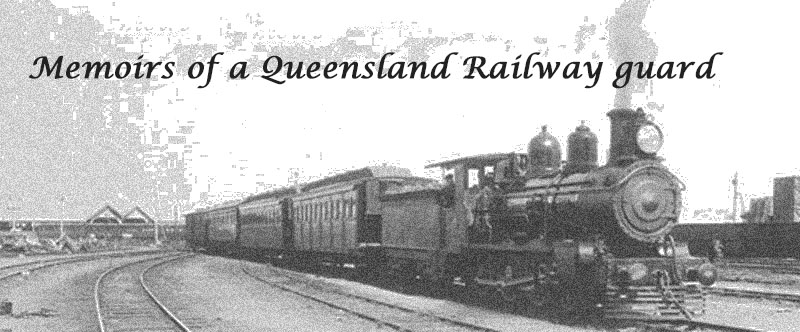|
|
|
|
Introduction PART 1: BYRNES FAMILY ANCESTORS’ CHARTS : (Parents of Peter Byrnes): INDIVIDUAL SUMMARIES
|
The Queensland Times, Friday, Nov 7, 1952: Railway Service A Guard’s Experiences – 6 (by T.A. Byrnes) In continuation of the resume of various classes of trains I have worked during my career as a guard…. Millions of tons of coal have been taken out of the West Moreton coal field. It has extended in the Rosewood district. A number of the colliery sides that were working about 40 years ago around Bundamba and Redbank loop line are now abandoned and in most placed the rails have disappeared. When the large electric crane came into use at the Woolloongabba coal wharf, there were several coal trains daily from Ipswich. These trains were known as A trains. The trains from Woolloongabba to Bundamba and return, were known as B trains. C trains ran from Rome Street and return to the Brisbane district. B13 engines, with small wheels, were able to bring a big tonnage from the loops on the “Bundamba end”. Guard (“Bricky”) Sargeant was stationed there for many years. There was no Westinghouse brake on the coal hoppers in those days. Guard Sargeant was perfect in pinning down the wagon brakes and in shunting could handle a good number of wagons also on the Redbank end of the loop. Guard Mat Davis was stationed there for many years. He also was an adept at pinning down brakes. I well remember the old Redbank station yard and the long siding on which all the coal trains were weighed. The old weighbridge was controlled by water, and the two shunters Jim Quinlan and Dinny Buckley, later as guards, did all the weighing of trains. These two men have long since joined the “Great Majority”. Mr George Armstrong was chief station master. REDBANK ACCIDENT It must be nearly half a century since the tragic accident happened when Driver George Less and P Mulholland were coming off the Redbank loop with a long coal train. The engine struck a cow just before reaching the Brisbane road and Driver Lee was killed and the fireman serious injured. NEW WEIGHING STATION When the new weighbridge was installed at Wolston Station, all the trains were weighed at that station. Some time after, the name was changed to Wacol, due to the name conflicting with Wilston, a Brisbane suburban district. The guards of the present day are relieved of hand braking the trains, due to the installation of the modern Westinghouse brake. I well remember before arriving at the top of Oxley bank, opposite Brittain’s brickworks siding, the coal trains pulled up and the guard had to go along his train and put down the coal hopper hand brakes. When the train arrived at Oxley station the brakes were lifted again. BALLAST TRAINS I have worked many ballast trains. For a short period I was on the Linville to Esk ballast train. This train obtained the ballast from a pit about half-a-mile this side of Linville. A temporary siding was laid down near the upper reaches of the Brisbane River and the line was re-conditioned with ballast as far as Esk. Ballast train working is very interesting. The guard has to make his own time table and cross the ordinary trains at staff stations. FIFTY MILES WALK In 1926, I received an invitation to compete in the first 50 miles walking championship, held in Sydney. This event took place on September 18, 1926. It started from Martin Place GPO Sydney to Upper Bankstown (25 miles) then return to the GPO. There were 26 entries, including those from South Australia, Victoria, New South Ales and myself, the only Queenslander. There was a London-to-Brighton walker, H W Barrett among the starters. The race was won by J Lewis, of Melbourne. Time, 9 hours 20 minutes. I finished in seventh place. A beautiful silver cup was first trophy and I received a gold medal. The race was well organised and conducted and witnessed by a large crowd of people en route. Bob McMurdo, of Booval, represented Queensland in 1927, and I again went to Sydney in 1928 and finished in sixth place. When the first 50 mile walk championship was held in Sydney in 1926, all the interstate competitors were the guests of the New South Wales Walking Club and were billeted at the YMCA building in Pitt Street, and made honorary members of the New South Wales Sports Club. The night before the event all competitors were medically examined by Dr Victor Coppleson, one of the leader medical officers of Sydney, at the YMCA building.
|
